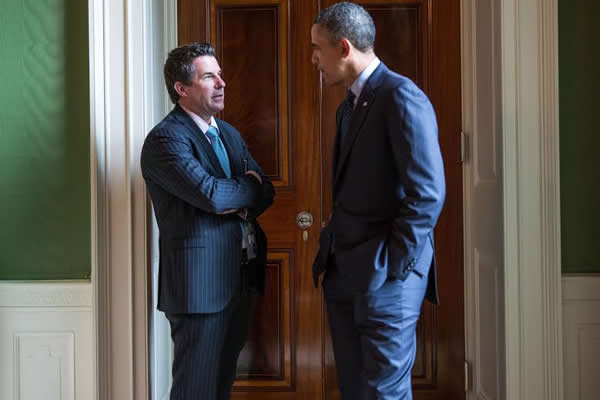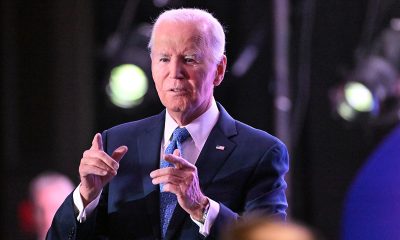Opinions
MLB’s support is a real game changer
Iconic American institution now on board with LGBT equality
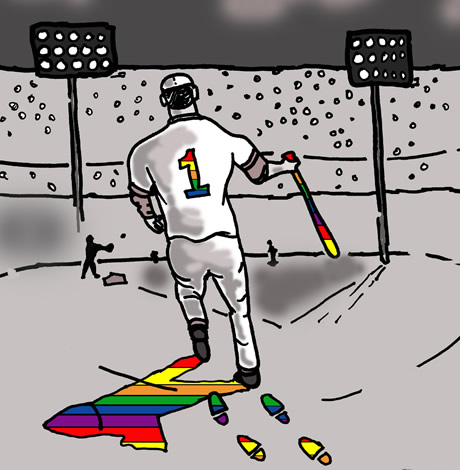
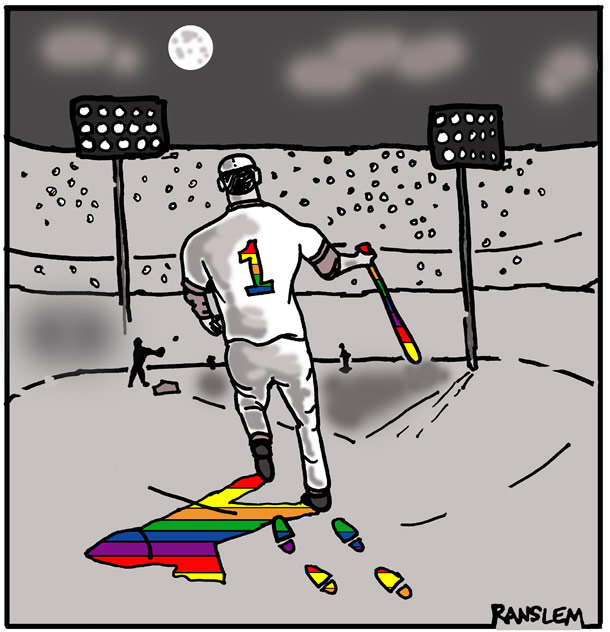
(Washington Blade cartoon by Ranslem)
By RYAN WAGNER
Picture this.
You’re in a ballpark. Your team is losing. Big. It’s the kind of game that would have made you leave in the fifth inning – if you were one of those fans who doesn’t believe your team will pull it out until the very last out is recorded. If you were one of those people who gives up.
All of a sudden your team gets a hit. And then another. Nothing special. A ground ball with eyes here, a dying quail there. But the buzz has started. You know the one I’m talking about. When 50,000 people all seem to begin to whisper simultaneously? The buzz.
Another hit, and this one scores a run or two. Now the buzz is a low rumble. Your team is still down, but there’s a glimmer of hope. This one ain’t over yet.
Now comes the big hit. The one that makes the sportswriters who have already written 90 percent of their game recaps stop, sigh and hit the delete button. The low rumble is now a roar. The game hasn’t been won, but the opponent is already defeated, and they’re not sure how it happened. The stars realigned, and that flighty temptress momentum changed her uniform.
In short, the narrative changed.
The fight for LGBT equality has undergone a similar change in narrative recently. For a long time, those battling in the trenches felt as though we were fighting a losing battle — always meeting with a loud, outspoken opposition that either didn’t care or simply didn’t understand. We weren’t exactly losing, but we certainly weren’t winning.
And then, all of a sudden, we got a couple of hits. Nothing big. A ground ball with eyes here, a dying quail there. Massachusetts became the first state to legalize gay marriage. Connecticut would follow, with Iowa and Vermont not far behind. The buzz started. You know the one I mean. When 100 million people all begin to whisper simultaneously? The buzz.
“Don’t Ask, Don’t Tell”, Prop 8 and DOMA were all struck down. The buzz became a low rumble.
The fight began to spill over into other areas of society, including the world of sports. Jason Collins came out. In light of inflammatory anti-LGBT policies in Russia, President Obama skipped the 2014 Sochi Olympics, opting instead to appoint tennis legend and gay rights champion Billie Jean King to lead the American contingent at the Opening Ceremonies. Michael Sam announced he’s gay prior to the NFL draft and in doing so, became the first openly gay man to sign a contract with an NFL team.
The low rumble became a roar, and the narrative had changed.
As a professional stage actor who also decided to pursue a career in the world of professional sports, I’m somewhat of an anomaly.
The relationships I forged with my friends in the theater world led me to assume that the fight for LGBT equality was on the forefront of the American social agenda. I assumed this because, for those of us traveling North America with a musical, it was simply a part of the vernacular.
In 2011, I was on the road with that musical when I learned I had been hired by Major League Baseball. I would be leaving the bubble that theater had created, and would be making the long, fascinating walk to the other side of the spectrum. In a span of three days, I went from a cocoon where my most important issue was the same as everyone else’s to a world where that issue was never even discussed. It wasn’t that LGBT equality was on the back burner for Major League Baseball. It had yet to make it onto the stove. Professional sports, particularly those considered the “Big 4,” are in many ways the last great bastion of masculinity and demonstrative heterosexuality. Anything that can be deemed a weakness is a liability. Any distraction is removed as quickly and quietly as possible. Which is why the three years that have passed since I first began my career in baseball have been so remarkable.
In a span of just a few years, I have had a front row seat for one of the most astounding, and most important, ideological shifts in social history. Thanks to the immediacy of information and (seriously) the power of social media, LGBT equality has gone from an issue on the periphery of the American agenda to one that finds itself front and center. And the catalyst for that tectonic shift has been sports. When the issue of homosexuality began showing up on the football field and the basketball court, the everyday, blue-collar American sports fan was forced to deal with it. As I watched Jason Collins and Michael Sam announce their homosexuality, my immediate thought was, “When will this tidal wave reach Major League Baseball?”
Baseball is America’s pastime. As James Earl Jones once remarked in “Field of Dreams,” “Baseball…has marked the times.” It has gotten us through some of the most tumultuous times in our nation’s history: World War II, the Civil Rights Movement, 9-11. It stands to reason that baseball would take the lead in this time of great struggle. But when was that going to happen? When was baseball going to realize the opportunity it had to make a statement to not only the rest of the sports landscape, but to the country and the world as a whole?
A few weeks ago, I got my answer. On July 15, Major League Baseball officially announced its partnership with Athlete Ally, an organization dedicated to fostering an environment of acceptance and inclusion for all LGBT athletes, coaches, and fans across all sports, professional and amateur.
When MLB announced that partnership — even Commissioner Bud Selig signed a pledge to become an Athlete Ally himself — it trumpeted a major victory for the entire LGBT community and their allies. Major League Baseball is not just a professional sports league. It is an organization that is American as American gets. It represents all that we hold dear in our most patriotic of hearts, and if something that American can say that being gay is not only OK, but is something worth fighting for, who would dare say otherwise?
There may be nothing more difficult than the growing pains of a transitioning social issue. Most people who have strongly held beliefs derive those beliefs from years and years of indoctrination. Change only comes when those screaming for change outnumber those who are plugging their ears and waiting for the din to quiet. With Major League Baseball now adding its voice to the roaring winds of change, the din may finally be too much to overcome.
In short, the narrative has changed. And now, at long last, maybe, just maybe, that flighty temptress momentum has changed her uniform.
Ryan Wagner is the PA announcer for the Baltimore Orioles.
Letter-to-the-Editor
Candidates should pledge to nominate LGBTQ judge to Supreme Court
Presidential, Senate hopefuls need to go on the record
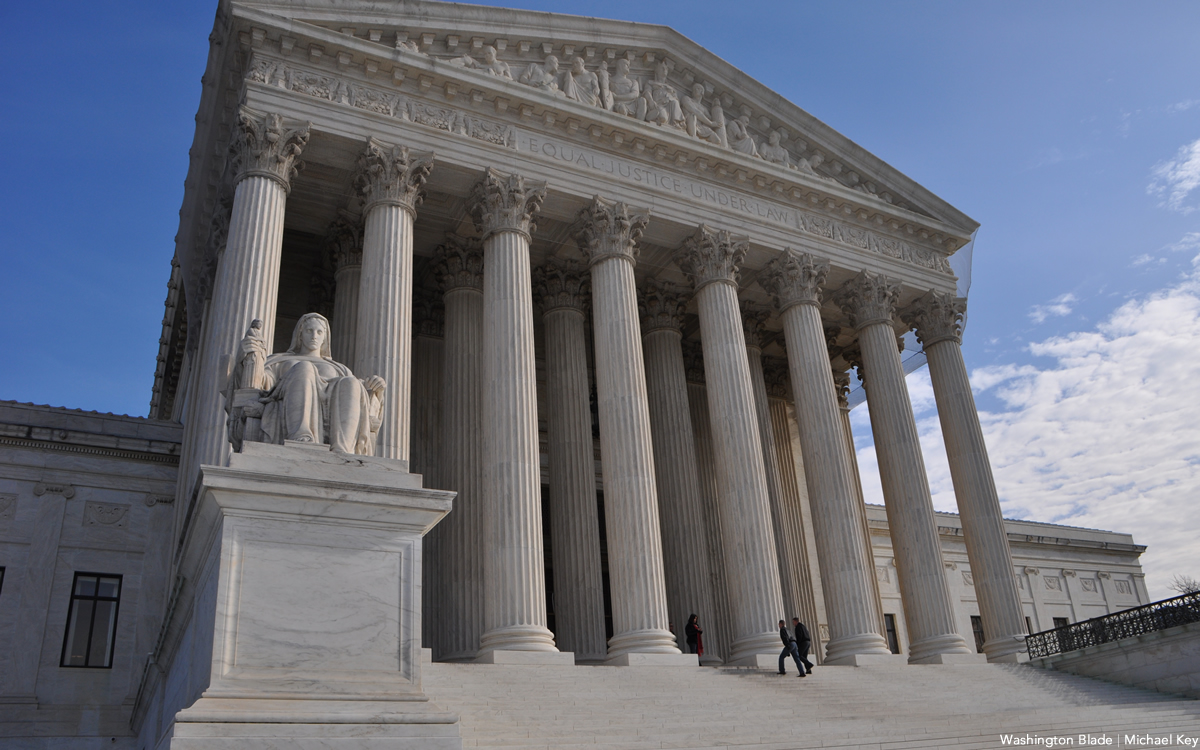
As soon as the final votes are cast and counted and verified after the November 2026 elections are over, the 2028 presidential cycle will begin in earnest. Polls, financial aid requests, and volunteer opportunities ad infinitum will flood the public and personal media. There will be more issues than candidates in both parties. The rending of garments and mudslinging will be both interesting and maybe even amusing as citizens will watch how candidates react to each and every issue of the day.
There is one particular item that I am hoping each candidate will be asked whether in private or in public. If a Supreme Court vacancy occurs in your potential administration, will you nominate an open and qualified LGBTQ to join the remaining eight?
Other interest groups on both sides have made similar demands over the years and have had them honored. Is it not time that our voices are raised as well? There are several already sitting judges on both state and federal benches that have either been elected statewide or approved by the U.S. Senate.
Our communities are being utilized and abused on judicial menus. Enough already! Challenge each and every candidate, regardless of their party with our honest question and see if honest answers are given. By the way … no harm in asking the one-third of the U.S. Senate candidates too who will be on ballots. Looking forward to any candidate tap dancing!
Opinions
2026 elections will bring major changes to D.C. government
Mayor’s office, multiple Council seats up for grabs
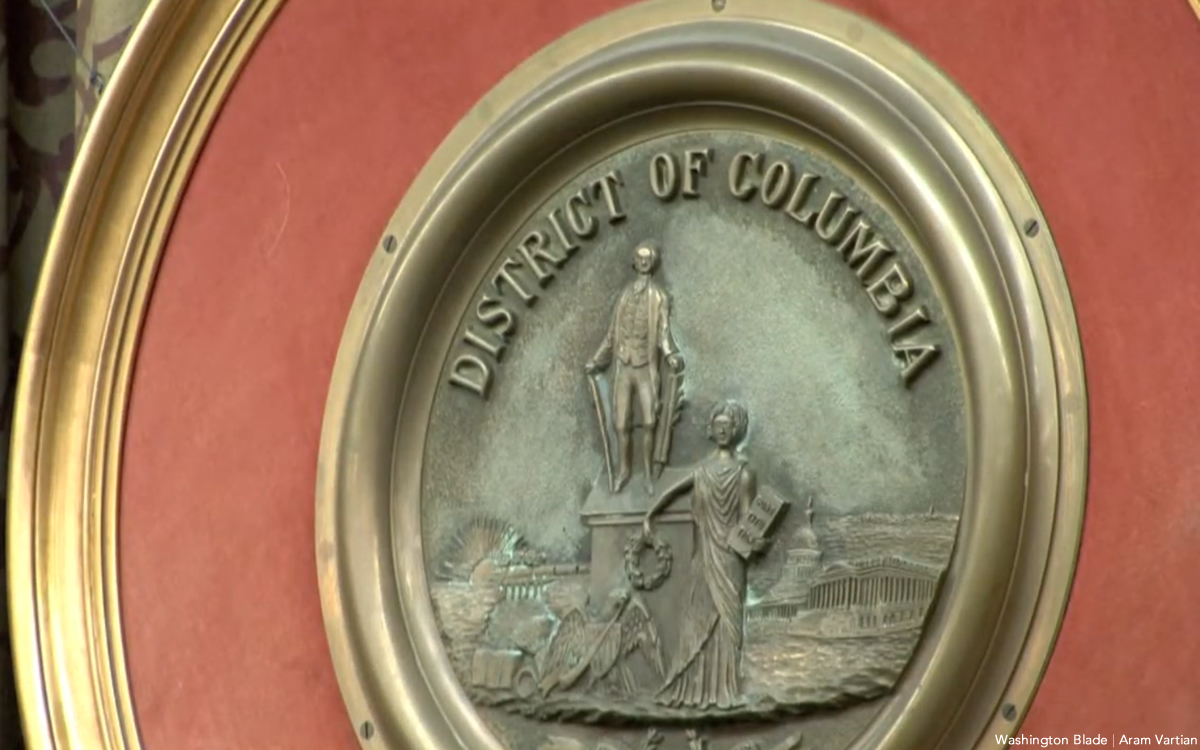
Next year will be a banner year for elections in D.C. The mayor announced she will not run. Two Council members, Anita Bonds, At-large, and Brianne Nadeau, Ward 1, have announced they will not run. Waiting for Del. Norton to do the same, but even if she doesn’t, there will be a real race for that office.
So far, Robert White, Council member at-large, and Brooke Pinto, Council member Ward 2, are among a host of others, who have announced. If one of these Council members should win, there would be a special election for their seat. If Kenyon McDuffie, Council member at-large, announces for mayor as a Democrat, which he is expected to do, he will have to resign his seat on the Council as he fills one of the non-Democratic seats there. Janeese George, Ward 4 Council member, announced she is running for mayor. Should she win, there would be a special election for her seat. Another special election could happen if Trayon White, Ward 8, is convicted of his alleged crimes, when he is brought to trial in January. Both the Council chair, and attorney general, have announced they are seeking reelection, along with a host of other offices that will be on the ballot.
Many of the races could look like the one in Ward 1 where at least six people have already announced. They include three members of the LGBTQ community. It seems the current leader in that race is Jackie Reyes Yanes, a Latina activist, not a member of the LGBTQ community, who worked for Mayor Fenty as head of the Latino Affairs Office, and for Mayor Bowser as head of the Office of Community Affairs. About eight, including the two Council members, have already announced they are running for the delegate seat.
I am often asked by candidates for an endorsement. The reason being my years as a community, LGBTQ, and Democratic, activist; and my ability to endorse in my column in the Washington Blade. The only candidate I endorsed so far is Phil Mendelson, for Council chair. While he and I don’t always agree on everything, he’s a staunch supporter of the LGBTQ community, a rational person, and we need someone with a steady hand if there really are six new Council members, out of the 13.
When candidates call, they realize I am a policy wonk. My unsolicited advice to all candidates is: Do more than talk in generalities, be specific and honest as to what you think you can do, if elected. Candidates running for a legislative office, should talk about what bills they will support, and then what new ones they will introduce. What are the first three things you will focus on for your constituents, if elected. If you are running against an incumbent, what do you think you can do differently than the person you hope to replace? For any new policies and programs you propose, if there is a cost, let constituents know how you intend to pay for them. Take the time to learn the city budget, and how money is currently being spent. The more information you have at your fingertips, the smarter you sound, and voters respect that, at least many do. If you are running for mayor, you need to develop a full platform, covering all the issues the city will face, something I have helped a number of previous mayors do. The next mayor will continue to have to deal with the felon in the White House. He/she/they will have to ensure he doesn’t try to eliminate home rule. The next mayor will have to understand how to walk a similar tightrope Mayor Bowser has balanced so effectively.
Currently, the District provides lots of public money to candidates. If you decide to take it, know the details. The city makes it too easy to get. But while it is available, take advantage of it. One new variable in this election is the implementation of rank-choice voting. It will impact how you campaign. If you attack another candidate, you may not be the second, or even third, choice, of their strongest supporters.
Each candidate needs a website. Aside from asking for donations and volunteers, it should have a robust issues section, biography, endorsements, and news. One example I share with candidates is my friend Zach Wahls’s website. He is running for United States Senate from Iowa. It is a comprehensive site, easy to navigate, with concise language, and great pictures. One thing to remember is that D.C. is overwhelmingly Democratic. Chances are the winner of the Democratic primary will win the general election.
Potential candidates should read the DCBOE calendar. Petitions will be available at the Board of Elections on Jan. 23, with the primary on June 16th, and general election on Nov. 3. So, ready, set, go!
Peter Rosenstein is a longtime LGBTQ rights and Democratic Party activist.
Opinions
Lighting candles in a time of exhaustion
Gunmen killed 15 people at Sydney Hanukkah celebration

In the wake of the shooting at Bondi Beach that targeted Jews, many of us are sitting with a familiar feeling: exhaustion. Not shock or surprise, but the deep weariness that comes from knowing this violence continues. It is yet another reminder that antisemitism remains persistent.
Bondi Beach is far from Washington, D.C., but antisemitism does not respect geography. When Jews are attacked anywhere, Jews everywhere feel it. We check on family and friends, absorb the headlines, and brace ourselves for the quiet, numbing normalization that has followed acts of mass violence.
Many of us live at an intersection where threats can come from multiple directions. As a community, we have embraced the concept of intersectional identity, and yet in queer spaces, many LGBTQ+ Jews are being implicitly or explicitly asked to play down our Jewishness. Jews hesitate before wearing a Magen David or a kippah. Some of us have learned to compartmentalize our identities, deciding which part of ourselves feels safest to lead with. Are we welcome as queer people only if we mute our Jewishness? Are those around us able to acknowledge that our fear is not abstract, but rooted in a lived reality, one in which our friends and family are directly affected by the rise in antisemitic violence, globally and here at home?
As a result of these experiences, many LGBTQ+ Jews feel a growing fatigue. We are told, implicitly or explicitly, that our fear is inconvenient; that Jewish trauma must be contextualized, minimized, or deferred in favor of other injustices. Certainly, the world is full of horror. And yet, we long for a world in which all lives are cherished and safe, where solidarity is not conditional on political purity or on which parts of ourselves are deemed acceptable to love.
We are now in the season of Chanuka. The story of this holiday is not one of darkness vanishing overnight. It is the story of a fragile light that should not have lasted. Chanuka teaches us that hope does not require certainty; it requires persistence and the courage to kindle a flame even when the darkness feels overwhelming.
For LGBTQ+ Jews, this lesson resonates deeply. We have survived by refusing to disappear across multiple dimensions of our identities. We have built communities, created rituals, and embraced chosen families that affirm the fullness of who we are.
To our LGBTQ+ siblings who are not Jewish: this is a moment to listen, to stand with us, and to make space for our grief. Solidarity means showing up not only when it is easy or popular, but especially when it is uncomfortable.
To our fellow Jews: your exhaustion is valid. Your fear is understandable, and so is your hope. Every candle lit this Chanuka is an act of resilience. Every refusal to hide, every moment of joy, is a declaration that hatred will not have the final word.
Light does not deny darkness. It confronts it.
As we light our candles this Chanuka season, may we protect one another and bring light to one another, even as the world too often responds to difference with violence and hate.
Joshua Maxey is the executive director of Bet Mishpachah, D.C.’s LGBTQ synagogue.

